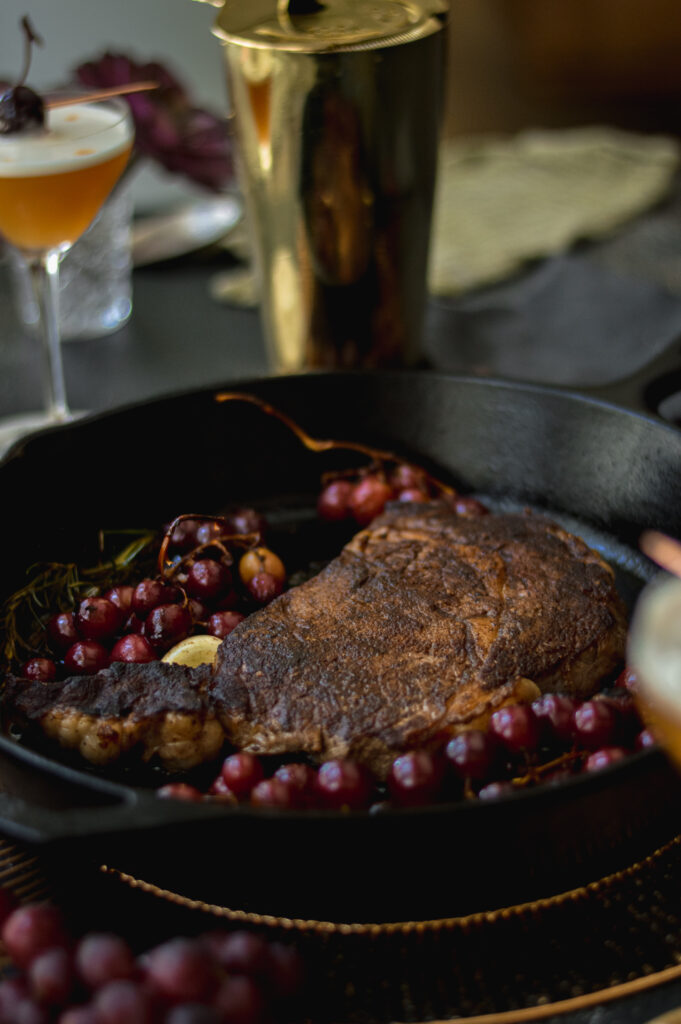As an Amazon Associate I earn from qualifying purchases.
Cast iron rib-eye steak is an amazing date-night recipe (or single night if you're super hungry). The cast iron means two things, you can cook it anytime of year (no need to be next to a grill when it's -30 outside), and you can cook it with grapes, garlic and rosemary. Not a super common combination, but a very, very good one to add to your repertoire. The rub on this steak is optional, but don't let the chocolate scare you! It just enhances the flavour of the beef, it doesn't taste like chocolate.
Jump to:

What is a Rib-eye Steak?
The Rib-eye (or rib steak, that's usually with the bone in) is the muscle that goes from the cow's hip to shoulder blade.

It's a great cut of beef because they're super tender, but at the same time, deeply flavorful (unlike the filet mignon, which tends to sacrifice flavour for tenderness). This area on the cow doesn't get much exercise, hence the tender aspect, and at the same time, fat gets deposited there, leading to the amazing marbling and flavour of the steak. It's really a win-win (win).
It can come with a bone, or with out. Bone in means it gets a bit more moisture and flavour, but it also means it can be harder to cook. The meat closest to the bone tends to cook more slowly than the rest (a good meat thermometer can really come in handy here). This recipe will work with or without the bone.
How to Cook a Rib-eye in Cast Iron
This has got to be one of the easiest, and quickest ways to cook a steak. First, let's get your steak ready. Rub it all over with some olive oil, salt and pepper. Next, rub it with the rub you just created (although, honestly, it's really fantastic with just salt and pepper as well). Next, preheat your oven to 400F. Now, it's time to whip out your cast iron. You need to get your skillet absolutely screaming hot. It should basically be smoking. Next, lay the steak in the pan, and sear it for about two minutes a side. The aim is not to cook the steak all the way through, but to caramelize the outside and create a golden crust that's full of flavour. Next, chuck the whole thing in the oven until the internal temperature reaches 125F for medium rare, pull it out, let it rest, and you're good to go.
Cooking the Grapes, Rosemary & Garlic
For this recipe, there's an extra step, but it's very easy. Add your grapes to the pan before your put your rib-eye in the oven, and as the steak is resting, we're going to hit the pan with the garlic, rosemary and some butter, just for a few minutes.
Internal Temperature for Medium-Rare
For most beef, the internal temperature for medium-rare is 130F. This means you want to take the steak out of the pan to rest when it hits 125F, or even 120F (I'd rather have my steak underdone than over, so I always take it out at 120F). You can of course cook your rib-eye to any doneness you please, but if you take it to well done, you're going to end up with a grey, tough hunk of meat with most of the fat cooked out of it.
For me, the absolute best way to check if your steaks are done is with an instant read meat thermometer, or a wireless digital meat thermometer. I have both of these thermometers, and it's been years since I've overcooked a piece of meat. Seriously, I cannot recommend these highly enough for your kitchen - it's a go-to!

Why Grapes?
I'm a huge fan of pairing sweet fruits with uber-savory red meat. To me it's a natural pairing, and I've experimented with it a lot over the years. The grapes provide a phenomenal flavour contrast with the beef, and with these guys being just slightly cooked, the warm, juicy texture also gives you a nice surprise when you bite into them.
What to Serve with Rib-Eye
Wine
Because rib-eye is the juiciest, fattiest cut of meat, it needs a full-bodied red to cut through some of that fat. You want the tannins in the wine to help break down the protein in the rib-eye, making taste even more juicy, and the fat in the steak relaxes the tannins, brining out all the tasting notes in the wine. It's a match made in heaven. Try a Cabernet Sauvignon, a Barolo (my personal fav) or a Syrah. All great choices, but again, this is not the place for a Pinot Noir or anything lighter in color.
Sides
You could serve any classic steak-house type of side with this dish. Hearty flavours and root vegetables with lots of carbs tend to stand up well with the meat. Here's a few different dishes I love with a good rib-eye:
Roasted Broccoli with Pecorino and Honey
The Ultimate Make-Ahead Mashed Potatoes
FAQ's
Yes, it's one of the fattiest cuts of beef. This gives it great marbling and flavour, making it a very popular cut.
The rib-eye comes from the muscle of the cow that stretches from it's shoulder blade to the hip.
Yes, very. It's not a muscle the cow uses very often, so it's definitely a tender cut of beef.
For medium-rare, it's 130F. This means you should stop the cooking process when it hits 125F on the grill or in a skillet (or oven).
📖 Recipe

Cast Iron Rib-Eye Steak with Blistered Grapes
Equipment
- Cast Iron Skillet
- Instant Read Meat Thermometer
Ingredients
- 1 large bone-in, rib-eye steak
- salt and pepper to taste
- 2 tablespoon cocoa powder
- 1 teaspoon chipotle chili powder
- 2 teaspoon brown sugar
- 1 tablespoon olive oil
- 2 tablespoon butter
- 3 C whole, seedless grapes
- 2 cloves garlic, peeled and smashed
- 1 sprig fresh rosemary
Instructions
- Preheat your cast iron skillet over medium-high heat. The pan should be smoking hot.
- Preheat your oven to 400°F.
- Rub your steak all over with salt and pepper. Set aside.
- Combine cocoa powder, chili powder, and brown sugar. Mix will and rub all over the steak.
- Add 1 tablespoon of olive oil to the pan, and immediately add the steak. Sear on both sides for 2 minutes, until golden brown (the sugar should help caramelize the outside).
- Add the grapes to the pan surrounding the steak. If the pan is super dry, add a bit of olive oil. Transfer the pan to the oven, and cook until the steak is 125°F for medium rare.
- Remove from the oven, and remove steak from the pan. Set on a wire rack to rest.
- Meanwhile, carefully add the butter, garlic, and rosemary to the pan (the skillet will be super hot, don't touch it!). Sauté for 4-5 minutes, until the grapes are blistered (almost burnt).
- Carve the steak into thin slices. Serve on a platter with grapes, rosemary and garlic, gathering up any pan drippings.
Notes
Nutrition
Jump to:
Hi, I'm Cara! I'm a food writer, journalist, and recipe developer. I'm obsessed good food, good wine, good cocktails and entertaining. I've picked up a few tips over the years, and love sharing them with others.




Leave a Reply